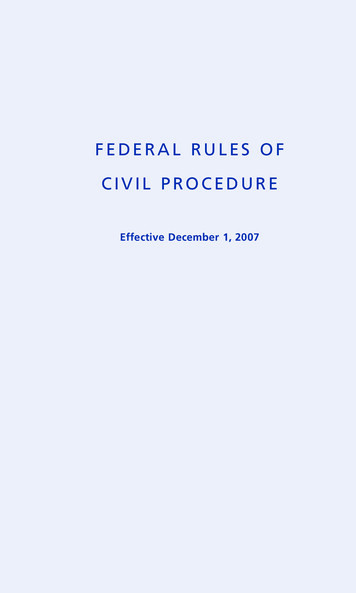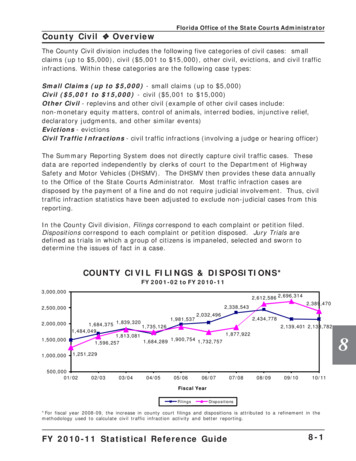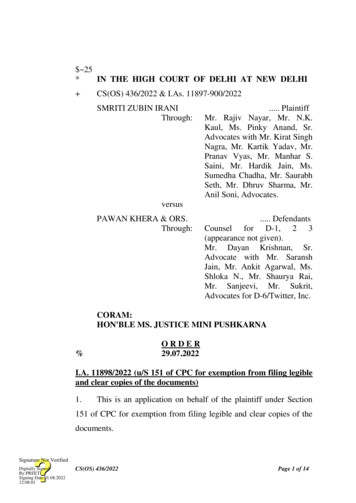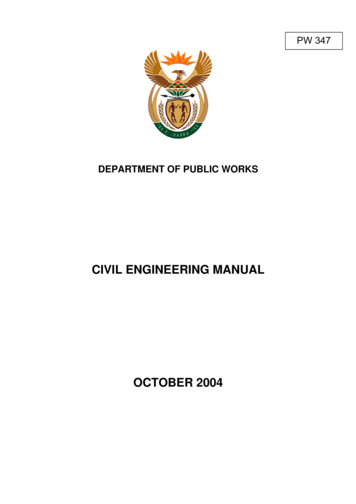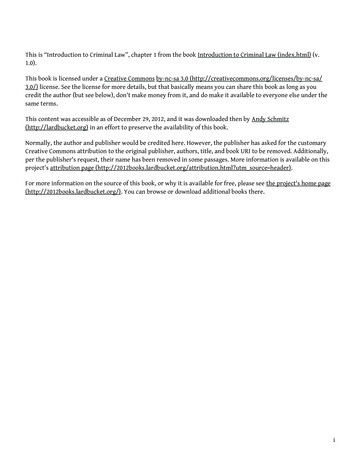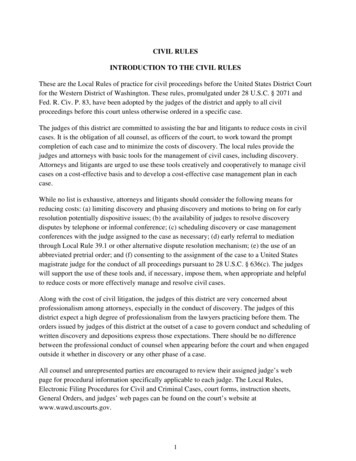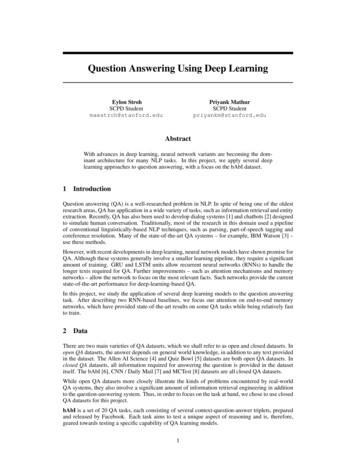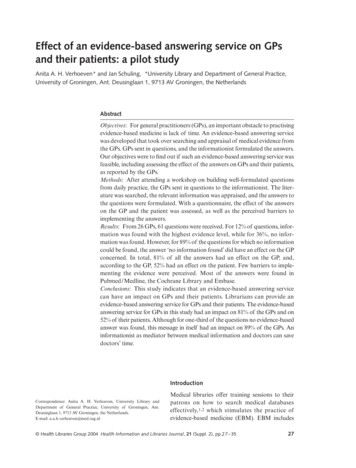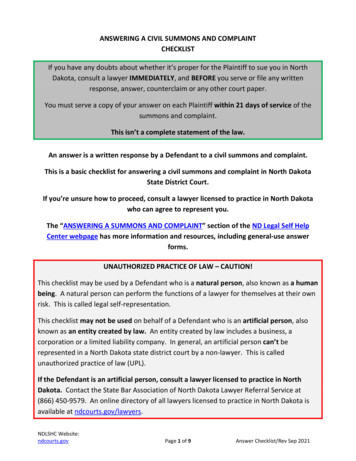
Transcription
ANSWERING A CIVIL SUMMONS AND COMPLAINTCHECKLISTIf you have any doubts about whether it’s proper for the Plaintiff to sue you in NorthDakota, consult a lawyer IMMEDIATELY, and BEFORE you serve or file any writtenresponse, answer, counterclaim or any other court paper.You must serve a copy of your answer on each Plaintiff within 21 days of service of thesummons and complaint.This isn’t a complete statement of the law.An answer is a written response by a Defendant to a civil summons and complaint.This is a basic checklist for answering a civil summons and complaint in North DakotaState District Court.If you’re unsure how to proceed, consult a lawyer licensed to practice in North Dakotawho can agree to represent you.The “ANSWERING A SUMMONS AND COMPLAINT” section of the ND Legal Self HelpCenter webpage has more information and resources, including general-use answerforms.UNAUTHORIZED PRACTICE OF LAW – CAUTION!This checklist may be used by a Defendant who is a natural person, also known as a humanbeing. A natural person can perform the functions of a lawyer for themselves at their ownrisk. This is called legal self-representation.This checklist may not be used on behalf of a Defendant who is an artificial person, alsoknown as an entity created by law. An entity created by law includes a business, acorporation or a limited liability company. In general, an artificial person can’t berepresented in a North Dakota state district court by a non-lawyer. This is calledunauthorized practice of law (UPL).If the Defendant is an artificial person, consult a lawyer licensed to practice in NorthDakota. Contact the State Bar Association of North Dakota Lawyer Referral Service at(866) 450-9579. An online directory of all lawyers licensed to practice in North Dakota isavailable at ndcourts.gov/lawyers.NDLSHC Website:ndcourts.govPage 1 of 9Answer Checklist/Rev Sep 2021
Carefully Review the Summons and Complaint:Carefully read the summons, complaint, and all papers you were served (received). The summons provides information about the deadline to serve your written answer to thecomplaint, who to serve, and the consequences of missing the deadline.The complaint lists the claims the Plaintiff is making against you.Calculate the Deadline to Answer a Civil Summons and Complaint:You, the Defendant, have twenty-one (21) days after you’re served the summons and copy of thecomplaint to respond or “answer” the complaint. Your answer must be in writing.See Rule 12 of the North Dakota Rules of Civil Procedure for more information about timeframesfor serving an answer. See Rule 6 of the North Dakota Rules of Civil Procedure for moreinformation about computing time. Date the summons and complaint were served on you, the Defendant: Using calendar days, calculate the date your written answer must be served on thePlaintiff(s):How to Calculate:A. Don’t include the day of the event that triggers the period (the date you were served);B. Count every day, including intermediate Saturdays, Sundays, and legal holidays; andC. Include the last day of the period, but if the last day is a Saturday, Sunday, or legalholiday, the period continues to run until the end of the next day that is not a Saturday,Sunday, or legal holiday.Make a Copy of the Complaint to Mark-Up:Make at least one copy of the complaint. Using the following checklists, go through your workingcopy of the complaint with a pencil and make notes. Note any points you want to make in youranswer.Use your marked-up copy of the complaint, and the following checklists, to help you organize andprepare your written answer.NDLSHC Website:ndcourts.govPage 2 of 9Answer Checklist/Rev Sep 2021
Jurisdiction:For a Plaintiff to start a civil action, they must show that North Dakota State District Courts have1. Subject matter jurisdiction; and The North Dakota laws and/or rules that say the North Dakota state district courtscan hear and make decisions about the case.2. Personal jurisdiction. The connection the Plaintiff(s) and Defendant(s) have to North Dakota.(See the “Jurisdiction” section of the Guide to a Civil Action for additional information and legalresearch resources for subject matter jurisdiction and personal jurisdiction.) Research the laws and/or rules the Plaintiff included in their complaint. Do you agree that North Dakota State District Courts have subject matter jurisdiction?If you don’t agree, explain why the laws and/or rules in the complaint don’t give subjectmatter jurisdiction to North Dakota State District Courts: Do you agree that North Dakota State District Courts have personal jurisdiction over eachof the parties in the civil action?If you don’t agree, explain why North Dakota State District Courts don’t have authorityover each of the parties. (Rule 4 of the North Dakota Rules of Civil Procedure gives thedefinition of a “person” and the requirements for exercising personal jurisdiction over aperson):Statute of Limitations:Statute of limitations is the amount of time allowed by law that a Plaintiff can bring a claim in acivil action. If the time has passed, the Plaintiff can’t bring the claim. Start your statute of limitations legal research with Chapter 28-01 of the North DakotaCentury Code (legis.nd.gov/cencode/t28c01.html). If the civil action doesn’t relate to realestate, start your research with Section 28-01-16. The Section(s) of the North Dakota Century Code with the statute of limitation for this civilaction is: and thestatute of limitations is years.NDLSHC Website:ndcourts.govPage 3 of 9Answer Checklist/Rev Sep 2021
Do you agree that the Plaintiff started the civil action within the statute of limitations? Yes NoIf you don’t agree, explain why the Plaintiff did not meet the statute of limitations tocollect this debt:Venue (Location of Civil Action within North Dakota):The Plaintiff(s) must determine the proper county in North Dakota for the North Dakota StateDistrict Court to hear and decide the subject matter of the civil action. (See the laws and/or rulesrelated to the subject matter and/or North Dakota Century Code Chapter 28-04.) Do you agree that the North Dakota State District Court inCounty is the proper county in North Dakota to hear and decide the subject matter of theaction?If you don’t agree, what is the proper North Dakota county?Explain why:Admit, Deny, or Insufficient Knowledge:For every claim in the Plaintiff’s complaint, your answer must either:1. Admit (agree);2. Deny (disagree); or3. State you don’t have enough knowledge or information to admit or deny the claim.(See Rule 8(b) of the North Dakota Rules of Civil Procedure for additional information.) Do you admit (agree with) any of the allegations (claims) listed in the complaint?List the specific paragraph numbers of the claims with which you completely agree: Do you deny (disagree) any of the allegations (claims) in the complaint?List the specific paragraph numbers of the claims with which you completely deny:NDLSHC Website:ndcourts.govPage 4 of 9Answer Checklist/Rev Sep 2021
Do you admit (agree) in part and deny (disagree) in part any of the allegations (claims) inthe complaint?List the specific paragraph number of the claims you admit in part and deny in part. Foreach, explain the part of the claim you admit and the part of the claim you deny: Do you have insufficient knowledge or information to either admit (agree) or deny(disagree) any of the allegations (claims) in the complaint?List the specific paragraph number of the claims you cannot admit or deny:Affirmative Defenses:An affirmative defense is a legal reason why the Plaintiff should lose, even if the Plaintiff’s claimsare true.Affirmative defenses must be listed in the answer. You may have more than one affirmativedefense. It’s also possible that you won’t have any affirmative defenses.You need to prove all affirmative defenses you list at trial. Begin your research with Rule 8, Rule 9 and Rule 12 of the North Dakota Rules of CivilProcedure for affirmative defense requirements. Do you have any affirmative defenses? List the affirmative defense in short, simple, andplain sentences describing the affirmative defense and demand for relief.Following are some common affirmative defenses in civil actions. The following affirmativedefenses aren’t all of the possible affirmative defenses. You must research affirmativedefenses more yourself. The North Dakota State District Court doesn’t have of subject-matter jurisdiction.(See Jurisdiction section above.) The summons and complaint weren’t properly served.(To determine if you were properly served, see ion for requirements for service of a summons and complaint.)NDLSHC Website:ndcourts.govPage 5 of 9Answer Checklist/Rev Sep 2021
The Plaintiff is suing the wrong person.(If this affirmative defense applies, explain why you believe the Plaintiff is suing thewrong person. For example, victim of identity theft or mistaken identity.) A different court has already decided this claim.(This affirmative defense may apply if the Plaintiff’s claim(s) was already part of adifferent court case and that court reached a decision. Include a certified orauthenticated copy of the order or judgment when you serve and file your answer.) The Plaintiff didn’t start the case before the statutes of limitations ran out.(See Statute of Limitations section above.) Other.List all other affirmative defenses in short, simple, and plain sentences describing theaffirmative defense and demand for relief:Answer Requests:You, the Defendant, must state what the Defendant wants the court to do, based on the responsesin the answer, and fully explain each request. List each request for relief, based on your responses in your answer:Counterclaim:A counterclaim is a written demand or request to the court for judgment granting the relief you,the Defendant, is seeking and allows you to bring claims against the Plaintiff. You may not haveany counterclaims. Research Rule 13 of the North Dakota Rules of Civil Procedure for counterclaimrequirements. (A counterclaim must meet all the requirements of a complaint.)NDLSHC Website:ndcourts.govPage 6 of 9Answer Checklist/Rev Sep 2021
Do you have any counterclaims?If no, don’t include a counterclaim in your answer.If yes, list the counterclaim(s) and the specific law or laws that support each counterclaim: Do North Dakota State District Courts have subject matter jurisdiction over thecounterclaim?List the specific law or laws that give North Dakota State District Courts authority to hearand determine and counterclaim: Do North Dakota State District Courts have personal jurisdiction?Explain how the North Dakota State District Court has authority over each of the parties inthe civil action. (Rule 4 of the North Dakota Rules of Civil Procedure gives the definition of a“person” and requirements for exercising personal jurisdiction over a person):Counterclaim Requests:You, the Defendant, must state what you want the court to do, based on the claims in yourcounterclaim against the Plaintiff(s). List each request for relief, based on your counterclaims:Create Your Documents to Answer a Civil Summons and Complaint: Answer (Used when you don’t have counterclaims) Fill in the top of the Answer exactly as it appears on the top of the summons List the paragraphs from the complaint that you admit (agree with) List the paragraphs from the complaint that you deny (disagree with) List the paragraphs from the complaint that you admit and deny. Explain the partof the claim you admit and the part you deny List the paragraphs from the complaint that you don’t have sufficient knowledge toeither admit or deny List your affirmative defenses, if any, in short plain sentences List your requests for relief, based on your answer responsesNDLSHC Website:ndcourts.govPage 7 of 9Answer Checklist/Rev Sep 2021
Don’t include confidential information as required by Rule 3.4 of the North DakotaRules of Court Signed and dated by you, the Defendant Make a copy for each Plaintiff, plus one copy to keep as a record. The original willbe filed with the Court*OR* Answer and Counterclaim (Used when you do have counterclaims) Fill in the top of the Answer and Counterclaim exactly as it appears on the summonsAnswer: List the paragraphs from the complaint that you admit (agree with) List the paragraphs from the complaint that you deny (disagree with) List the paragraphs from the complaint that you admit and deny. Explain the partof the claim you admit and the part you deny List the paragraphs from the complaint that you don’t have sufficient knowledge toeither admit or deny List your affirmative defenses, if any, in short plain sentences List your requests for relief, based on your answer responsesCounterclaim: Explain how the court has subject matter jurisdiction and personal jurisdiction Explain how the North Dakota county is the proper venue for the civil action Describe the counterclaim(s) in short, plain statements showing the you’re entitledto relief List your demands for relief, based on your counterclaim Don’t include confidential information as required by Rule 3.4 of the North DakotaRules of Court Signed and dated by you, the Defendant Make a copy for each Plaintiff, plus one copy to keep as a record. The original willbe filed with the Court*AND* Confidential Information Form Fill in the top of the Confidential Information Form exactly as it appears on the topof the summons Fill in the full information that cannot be included in documents filed with the Court(See Rule 3.4 of the North Dakota Rules of Court) Make a copy to keep as a record, the original will be filed with the CourtNDLSHC Website:ndcourts.govPage 8 of 9Answer Checklist/Rev Sep 2021
Service of Answer *OR* Answer and Counterclaim:You must arrange to serve a copy of your answer (or answer and counterclaim) on each Plaintiffwithin twenty-one (21) days of service of the summons and complaint. A completed and signeddeclaration of service, or affidavit of service, is proof that service occurred. Review service requirements in Rule 5 of the North Dakota Rules of Civil Procedure. Formore information about service requirements after a civil action has been started, go tothe Service link on the ND Legal Self Help Center webpage. Find the address for each Plaintiff, or, the Plaintiff’s lawyer, if the Plaintiff is represented. Arrange for service of a copy of your answer, and attachments (if any), on each Plaintiff.If a Plaintiff is represented by a lawyer, arrange to serve the lawyer instead of the Plaintiff. For each Plaintiff, get the completed and signed declaration of service, or affidavit ofservice, of the answer.Filing the Answer and Confidential Information Form with the North Dakota State District Court:(See the “Filing Documents with the District Court” section of the Guide to a Civil Action foradditional information, including when a Defendant can file the summons and complaint.)*** Filing a document isn’t the same as serving a document. Filing doesn’t meet therequirements for service. ***You must file your original answer, attachments (if any), confidential information form, and proofof service of the answer on each Plaintiff within a reasonable amount of time after being servedthe notice of filing the summons and complaint.You’ll be required to pay a filing fee. The filing fee for an answer is 50.00.If you can’t afford to pay the 50.00 filing fee, you may ask to have the filing fee waived.Forms and instructions are available at ndcourts.gov/legal-self-help/fee-waiver. File the request atthe same time your file your answer, confidential information form, and proof of service.You must serve notice of filing the answer on the Plaintiff.***The North Dakota Legal Self Help Center provides resources to people who represent themselves in civilmatters in the North Dakota state courts. The information provided by the Center isn’t intended for legaladvice but only a general guide to the civil court process. The Center isn’t responsible for any consequencesthat may result from the information provided. The information can’t replace the advice of competent legalcounsel licensed in the state.Use at your own risk.***NDLSHC Website:ndcourts.govPage 9 of 9Answer Checklist/Rev Sep 2021
You must serve a copy of your answer on each Plaintiff . within 21 days of service. of the summons and complaint. This isn't a complete statement of the law. An answer is a written response by a Defendant to a civil summons and complaint. This is a basic checklist for answering a civil summons and complaint in North Dakota State District Court.
